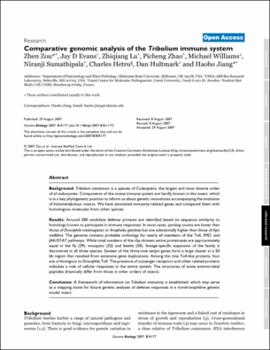| dc.contributor.author | Zou, Zhen | |
| dc.contributor.author | Evans, Jay D. | |
| dc.contributor.author | Lu, Zhiqiang | |
| dc.contributor.author | Zhao, Picheng | |
| dc.contributor.author | Williams, Michael | |
| dc.contributor.author | Sumathipala, Niranji | |
| dc.contributor.author | Hetru, Charles | |
| dc.contributor.author | Hultmark, Dan | |
| dc.contributor.author | Jiang, Haobo | |
| dc.date.accessioned | 2019-09-25T18:24:47Z | |
| dc.date.available | 2019-09-25T18:24:47Z | |
| dc.date.issued | 2007-08-29 | |
| dc.identifier | oksd_zou_comparativegeno_2007 | |
| dc.identifier.citation | Zou, Z., Evans, J. D., Lu, Z., Zhao, P., Williams, M., Sumathipala, N., ... Jiang, H. (2007). Comparative genomic analysis of the Tribolium immune system. Genome Biology, 8(8), Article R177. https://doi.org/10.1186/gb-2007-8-8-r177 | |
| dc.identifier.uri | https://hdl.handle.net/11244/321451 | |
| dc.description.abstract | Background: Tribolium castaneum is a species of Coleoptera, the largest and most diverse order of all eukaryotes. Components of the innate immune system are hardly known in this insect, which is in a key phylogenetic position to inform us about genetic innovations accompanying the evolution of holometabolous insects. We have annotated immunity-related genes and compared them with homologous molecules from other species. | |
| dc.description.abstract | Results: Around 300 candidate defense proteins are identified based on sequence similarity to homologs known to participate in immune responses. In most cases, paralog counts are lower than those of Drosophila melanogaster or Anopheles gambiae but are substantially higher than those of Apis mellifera. The genome contains probable orthologs for nearly all members of the Toll, IMD, and JAK/STAT pathways. While total numbers of the clip-domain serine proteinases are approximately equal in the fly (29), mosquito (32) and beetle (30), lineage-specific expansion of the family is discovered in all three species. Sixteen of the thirty-one serpin genes form a large cluster in a 50 kb region that resulted from extensive gene duplications. Among the nine Toll-like proteins, four are orthologous to Drosophila Toll. The presence of scavenger receptors and other related proteins indicates a role of cellular responses in the entire system. The structures of some antimicrobial peptides drastically differ from those in other orders of insects. | |
| dc.description.abstract | Conclusion: A framework of information on Tribolium immunity is established, which may serve as a stepping stone for future genetic analyses of defense responses in a nondrosophiline genetic model insect. | |
| dc.format | application/pdf | |
| dc.language | en_US | |
| dc.publisher | BioMed Central | |
| dc.rights | This material has been previously published. In the Oklahoma State University Library's institutional repository this version is made available through the open access principles and the terms of agreement/consent between the author(s) and the publisher. The permission policy on the use, reproduction or distribution of the material falls under fair use for educational, scholarship, and research purposes. Contact Digital Resources and Discovery Services at lib-dls@okstate.edu or 405-744-9161 for further information. | |
| dc.title | Comparative genomic analysis of the Tribolium immune system | |
| osu.filename | oksd_zou_comparativegeno_2007.pdf | |
| dc.description.peerreview | Peer reviewed | |
| dc.identifier.doi | 10.1186/gb-2007-8-8-r177 | |
| dc.description.department | Entomology and Plant Pathology | |
| dc.type.genre | Article | |
| dc.type.material | Text | |
| dc.subject.keywords | additional data file | |
| dc.subject.keywords | hemocyte | |
| dc.subject.keywords | holometabolous insect | |
| dc.subject.keywords | family expansion | |
| dc.subject.keywords | serpin gene | |
